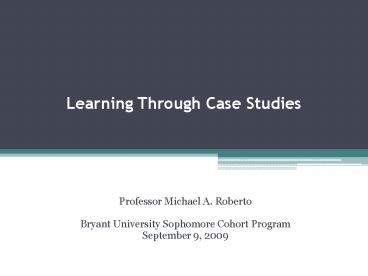Learning Through Case Studies - PowerPoint PPT Presentation
1 / 12
Title:
Learning Through Case Studies
Description:
Build your skills in diagnosis and problem definition. ... How to Attack a Case Step 2 ... Sheds insight through careful original analysis. ... – PowerPoint PPT presentation
Number of Views:25
Avg rating:3.0/5.0
Title: Learning Through Case Studies
1
Learning Through Case Studies
- Professor Michael A. Roberto
- Bryant University Sophomore Cohort Program
- September 9, 2009
2
Why the Case Method?
- Management is a skill more than it is a
collection of techniques and concepts. - - Prof. Ben Shapiro, Harvard Business School
For a useful guide to case analysis, you may
download (for free) the following article
published by McGraw-Hill at this
URL http//highered.mcgraw-hill.com/sites/dl/fre
e/0072969431/362614/guide_to_case_analysis.pdf
3
Standing in Someone Elses Shoes
- Put yourselves in the shoes of the general
manager or management team, who often will have
an important decision to make. - Sometimes, those decisions will be discussed
explicitly in the case - On other occasions, you will have to infer the
key problems, opportunities, and decisions facing
the organization.
4
Inductive vs. Deductive Learning
Theory
Reality
Reality
Theory
DEDUCTIVE
INDUCTIVE
5
Objectives of Case Analysis
- Increase your understanding of effective vs.
ineffective managerial practice. - Build your skills in diagnosis and problem
definition. - Get valuable practice in developing and
evaluating alternatives, and then formulating a
recommended plan of action. - Enhance your business judgment, as opposed to
uncritically accepting what the professor or text
says. - Gain in-depth exposure to many industries and
companies, thereby acquiring something close to
actual business experience.
Adapted from McGraw Hills Guide to Case Analysis
6
How to Attack a Case Step 1
- Check where you are in the course.
- What topics does the faculty member intend to
address this week? - What concepts and theories will be discussed?
- What did you cover last week in class?
- How does this case fit in the big picture of the
course? - Why do you think the faculty member selected this
case at this particular point in time?
7
How to Attack a Case Step 2
- Read the assignment/questions that your faculty
member provides to you. - The assignment/questions should guide you as you
read and analyze the case. - You should be prepared to answer those questions
thoroughly if called upon during our class
discussion.
8
How to Attack a Case Step 3
- Examine the text chapters and any articles that
have been assigned along with the case study. - Those readings will introduce you to certain
frameworks and concepts that will be helpful as
you try to analyze the case for that week. - Case analysis does not entail simply forming an
opinion about a management situation. - Good case analysis means applying key concepts
and frameworks to help you diagnose a management
situation and come to an INFORMED JUDGMENT.
9
How to Attack a Case Step 4
- Now, its time to turn to the case study itself!
- Skim the case to get an overview of the
situation. - Read the case thoroughly to digest key facts.
- Carefully review the exhibits.
- Decide what the issues/problems are.
- Crunch a few numbers how is the firm doing?
- Apply the concepts/techniques youve been
studying. - Examine the validity of information and
assumptions. - Identify the key causes of the current problem.
- Develop several alternative courses of action.
- Select your recommendation(s) buttressed with
solid supporting evidence, reasoning, and
analysis.
Adapted from McGraw Hills Guide to Case Analysis
10
Class Participation
- Good participation begins with good listening
build off the points of others. - A constructive comment does one of more of the
following - Sheds insight through careful original analysis.
- Provides additional supporting evidence for a
point that has already been made. - Challenges the underlying assumptions made by
others. - Offers a thought-provoking dissenting view
(playing the Devils Advocate) - Asks a question that clarifies a point for the
class, or provokes inquiry and debate.
11
Case Memos/Write-ups
- Be clear and concise.
- Watch your grammar and spelling.
- Write in the active voice.
- Explain your calculations clearly.
- Use exhibits to supplement your text.
- Be sure to refer to and explain the exhibits as
you write the body of your memo. - Demonstrate that you have considered the
benefits, costs, and risks of your
recommendation. - FOCUS ON ANALYSIS, NOT REGURGITATION!
12
- How we teach is what we teach.
- John McArthur
- The most common source of management mistakes is
not the failure to find the right answer. Its
the failure to ask the right questions. - Peter Drucker































